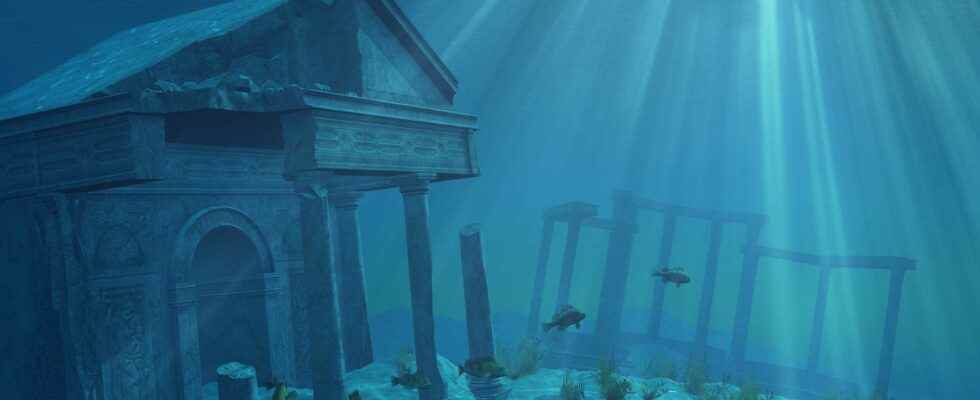A former pirate port in the Caribbean, a rich Roman seaside town, rows of statues in China… These vestiges of submerged cities maintain the mystery of ancient civilisations. Discover their history.
You will also be interested
The term sunken city inevitably brings to mind atlantis, a mythical island the size of a continent and dedicated to the god of the sea Poseidon, who would have suddenly disappeared during a cataclysm. Although Atlantis has given rise to many fantasies and fictions, its trace has never been found, unlike real cities submerged by water and whose vestiges remain. submarines. Discover the history of these cities sunken.
Heracleion (Egypt)
Located in Aboukir Bay, near Alexandria in the Nile Delta, the ancient city of Heracleion is now submerged under eight meters of water. According to legend, Heracleion was abandoned 1,200 years ago following a earthquake which triggered a tidal wave. The city, a former trade port and religious center, was discovered in 2000 by French archaeologist Franck Goddio and his team. Real archaeological treasures have been found there, including huge pink granite stelae 6.10 meters high, temples, bronze objects, gold coins, sarcophagi of mummified animals as well as numerous wrecks.
Shi Sheng (China)
Also called City of lions, Shi Sheng found herself submerged in 1959 during the creation of the Xin’an dam, 400 kilometers from Shanghai. Fifty thousand hectares were flooded and 290,000 people evacuated, including the inhabitants of Lion City, a 1,600-year-old city that was the cultural and historical center of the province in the 7e and VIIIe centuries. Fallen into oblivion until the 2000s, the city has once again become a tourist spot for divers. Located between 26 and 40 meters under water, Shi Sheng is home to magnificent statues, sculptures of lions and dragons, cobblestone roads and arches.
Port Royal (Jamaica)
Seat of British government in the 17th centurye century, Port-Royal was a hub of piracy in the Caribbean. Sometimes nicknamed “Pompeii of the New World”, the city was then one of the most prosperous towns in the region, with its taverns, games and pass rooms and its shops. Built largely on the sandPort-Royal literally collapsed into the sea during an earthquake followed by a tsunami June 7, 1692, which will cause about 3,000 victims. The English then decided to build a port level, Kingston, located a few kilometers away. Due to reduced underwater visibility, researchers set out to map the ruins In 3D.
Bayes (Italy)
Once a rich seaside resort in ancient Rome, Baiae now sleeps in the sea 16 kilometers off Naples. The city still has the remains of luxurious villas including those of the emperors Julius Caesar and Nero. You can also admire the Roman baths and saunas practically intact, casinos, statues, mosaics, and numerous works of art. Decimated by Muslim invaders in the VIIIe century then by malaria in 1500, Baia finally gradually slid into the sea due to volcanic activity in the area. Many sculptures have been transferred to museums, but the foundations of the city are visible through the crystal clear waters when you take a little height.
Pavlopetri (Greece)
Greek port city during the Bronze Age, Pavlopetri was abandoned in the VIIIe century BC due to the advance of the sea. Located today at a depth of about four meters in the extreme south of the Peloponnese, the site is remarkably well preserved. We have thus been able to reconstruct the almost complete plan of the city, with its streets, its buildings, and its tombs dating from the Mycenaean period (1600 to 1100 BC). Ceramic objects dating from the Neolithic period have also been discovered, suggesting that the city is even older than expected (5,000 years).
Dunwich (UK)
Nicknamed “British Atlantis”, Dunwich, in Suffolk in the south-east of England, was one of the largest cities in the country in the 11the century. But during the XIIIe and XIVe centuries, a succession of storms have eroded the coast and the city ended up being engulfed under more than 10 meters of water. Thanks to ultrasonic surveys, the researchers discovered several buildings and churches, pottery, shipwrecks. However, it is difficult to get a glimpse of it, because the visibility is extremely poor and it is almost impossible to take pictures.
Yonaguni-jima (Japan)
This mysterious pyramid lies between 30 meters and 5 meters under water in the south of the island of Yonaguni, about a hundred kilometers east of Taiwan. It was discovered in 1985 by Kihachiro Aratake during a scouting for tourist dives. Its origin is still debated by scientists: for some, the impressive structure in sandstone consisting of wide steps and smooth walls is of natural origin, but others believe that it is the remains of a 5,000 year old city. The site could also have served as a stone quarry or as foundations for buildings that have since been destroyed. Either way, Yonaguni is one of the top diving spots in the area.
Las Structures de Yonaguni is a group of structures found on the Japanese island of Yonaguni, which was released in 1985 by the Japanese submarinista Kihachirō Aratake, quien las halló por casualidad. pic.twitter.com/QKqfLaqC63
— Historia y Arqueología™ (@redhistoria) January 10, 2020
Atlit Yam (Israel)
Covering 40,000 square meters, the Atlit-Yam underwater site lies at a depth of 10 meters about 400 meters off the coast in northern Israel. It was discovered in 1984 by archaeologist Ehud Galili, who spotted a mound of rough stones that turned out to be a well. The city of Atlit Yam is said to be at least 9,000 years old and the artefacts found indicate that it was a prosperous maritime community. In particular, there was found a “mini-Stonehenge”, with a circle of standing stones, and other funerary objects dating from the Neolithic. Scientists remain divided on the causes of its disappearance: tsunami caused by a Etna eruption or gradual rise in water levels linked to global warming of the end of the Ice Age?
Interested in what you just read?
